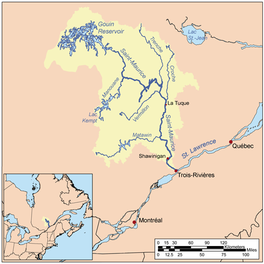|
Oskélanéo Lake
Oskélanéo Lake is a freshwater body linked to the southwestern part of the Gouin Reservoir (via Bureau Lake (Gouin Reservoir), in the territory of the town of La Tuque, in the administrative region of Mauricie, in the province of Quebec, Canada. All of the lake is in the canton of Faucher. Since the completion of the Gouin Dam in 1948, the navigability between the Gouin Reservoir and Lake Oskélanéo has become even easier with only two meters of difference in elevation. Recreational tourism activities are the main economic activity of the sector, followed by orestry. The Canadian National Railway cuts Oskélanéo Lake east-west in its middle through the village of Oskélanéo, on the west nbank. Route 404 serves the valley of the Oskélanéo River and connects to the Southeast at Route 400, which connects the Gouin Dam and the village of Parent, Quebec, also serves the valleys of rivers Jean-Pierre and Leblanc. The former road also serves the peninsula, which stretches north in the Gouin Reservoir on 30.1 kilometres (18.7 mi). A few secondary forest roads are in use nearby for forestry and recreational tourism activities. The surface of Oskélanéo Lake is usually frozen from mid-November to late April, but the period of safe ice circulation is generally from early December to late March. GeographyThe surrounding hydrographic slopes of Lake Oskélanéo are:
The Oskélanéo Lake is Haylow Bay advancing westward 2.1 kilometres (1.3 mi) near the mouth of the lake. This lake is mainly fed by the Parker and Froissart streams, as well as by the outlet of Hill Lake (via Haylow Bay) and the outlet (coming from the South) of Marcotte and Bisborne Lakes. This lake is split in two by a strait (North-South direction) of 5.2 kilometres (3.2 mi), located north of the railway bridge spanning the lake at the height of the village of Oskélanéo. The mouth of Lake Oskélanéo is located at:
From the mouth, the current flows over 149.2 kilometres (92.7 mi) to Gouin Dam, according to the following segments:
ToponymyThe toponym "Lac Oskélanéo" was formalized on December 5, 1968, by the Commission de toponymie du Québec, when it was created.[2] Notes and references
See also
|
||||||||||||||||||||||||||

